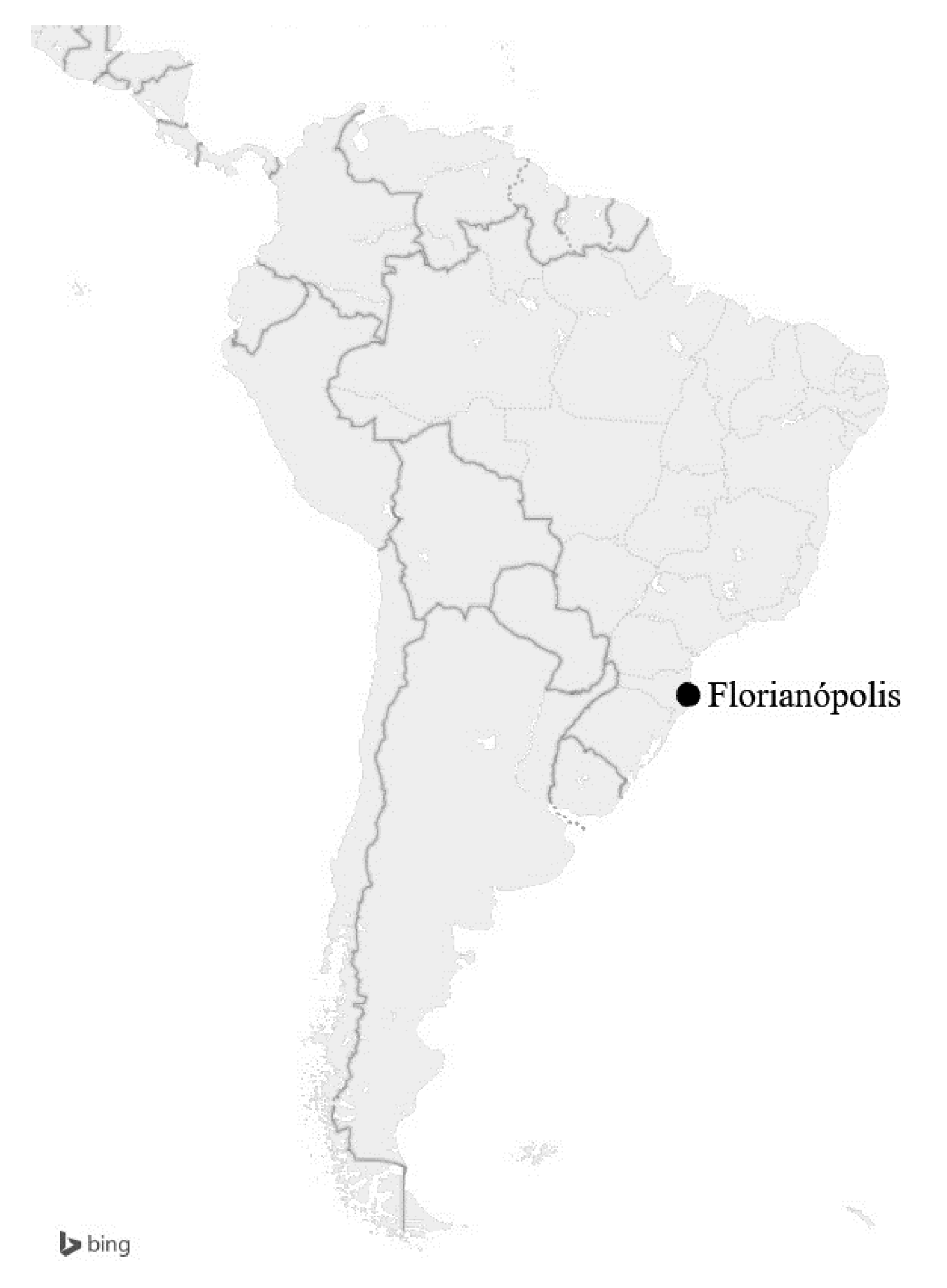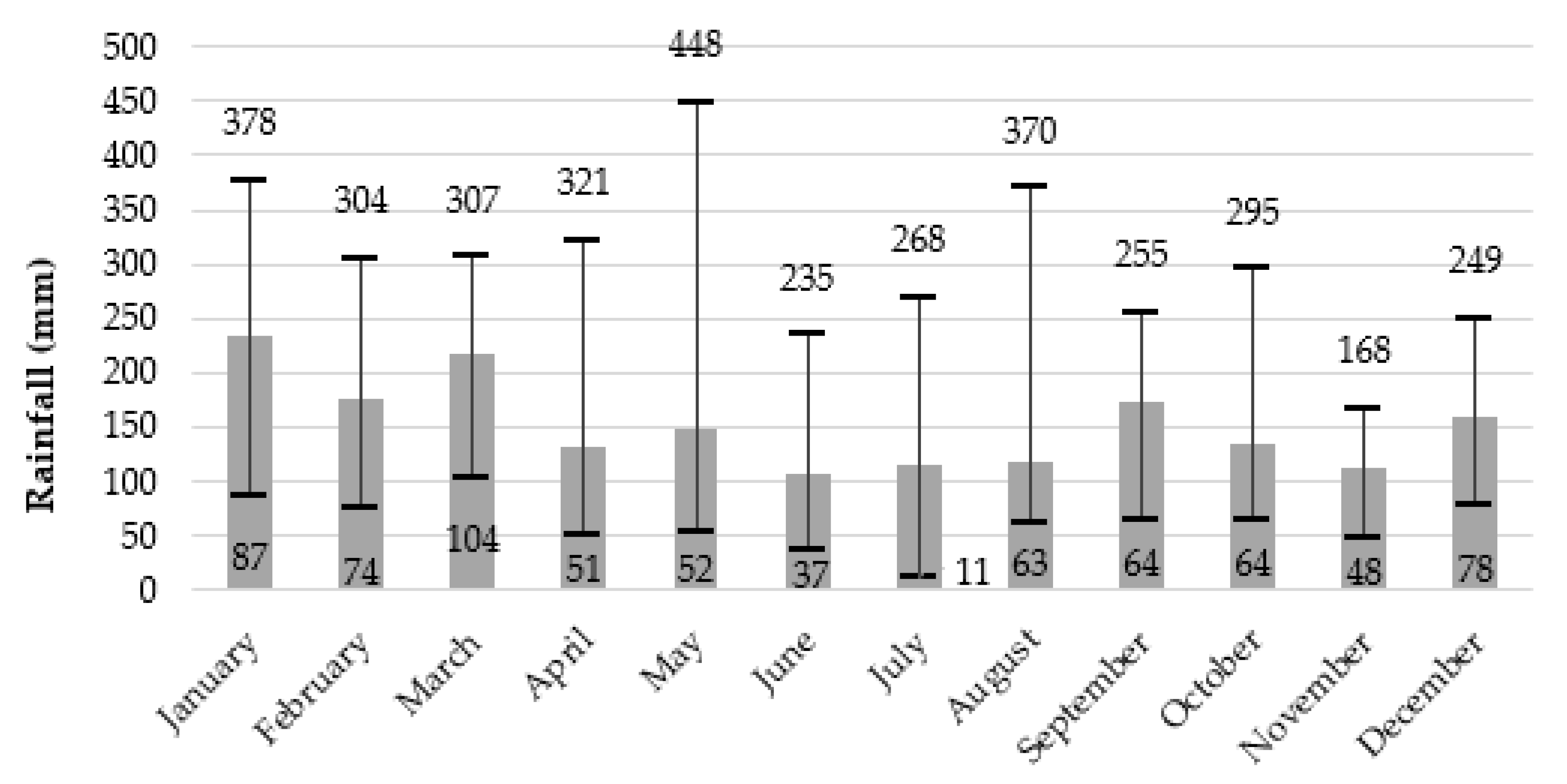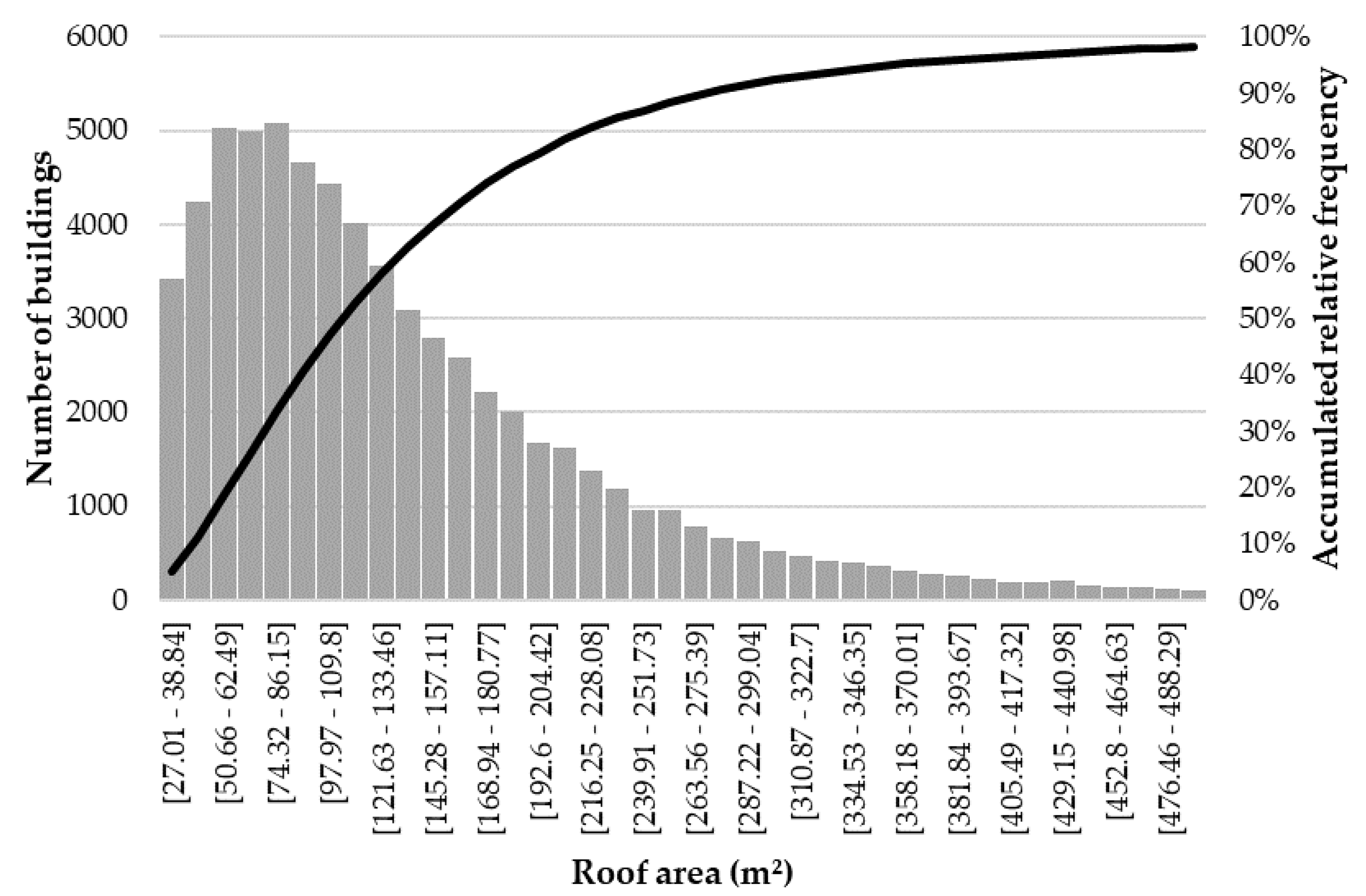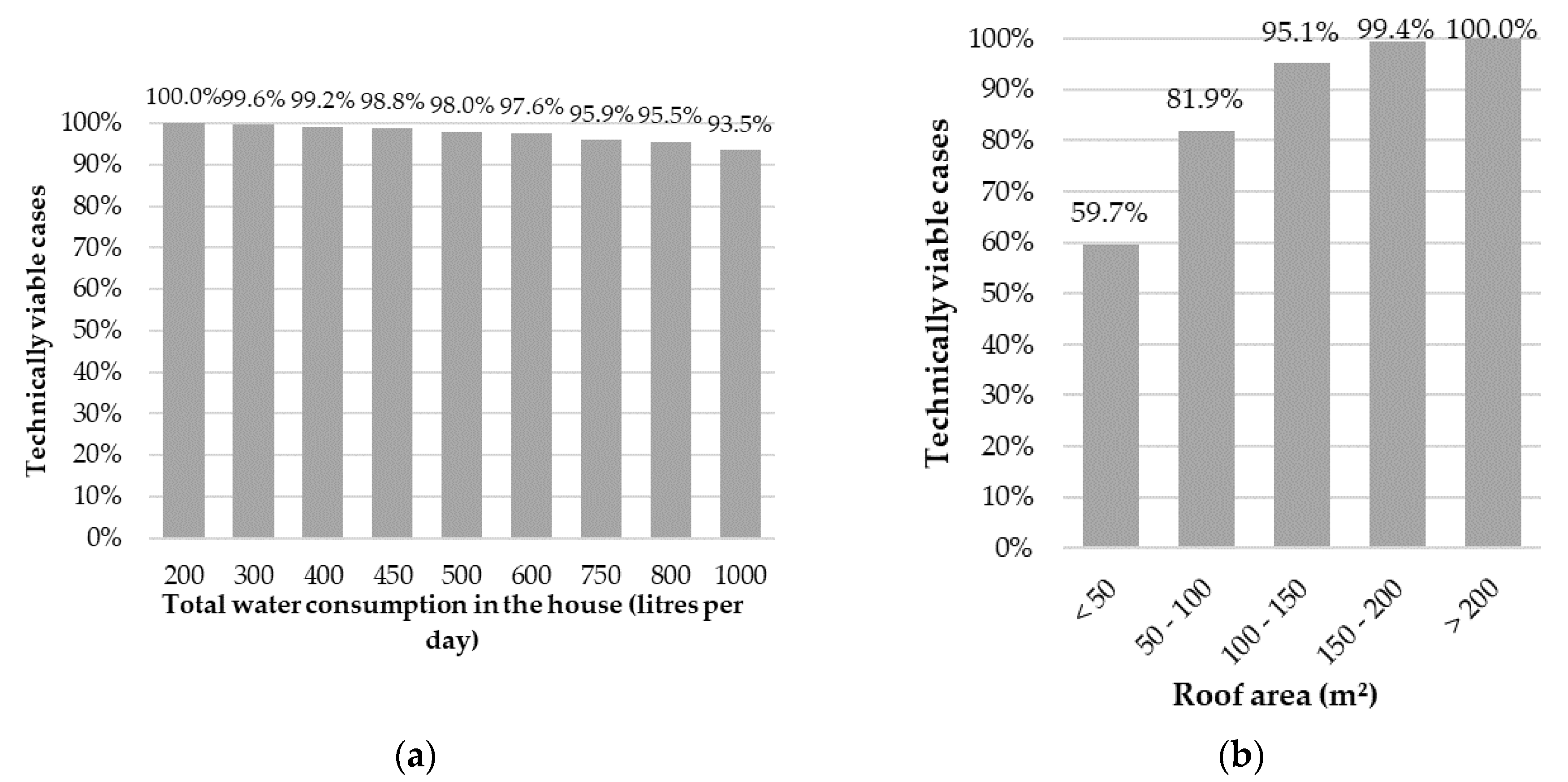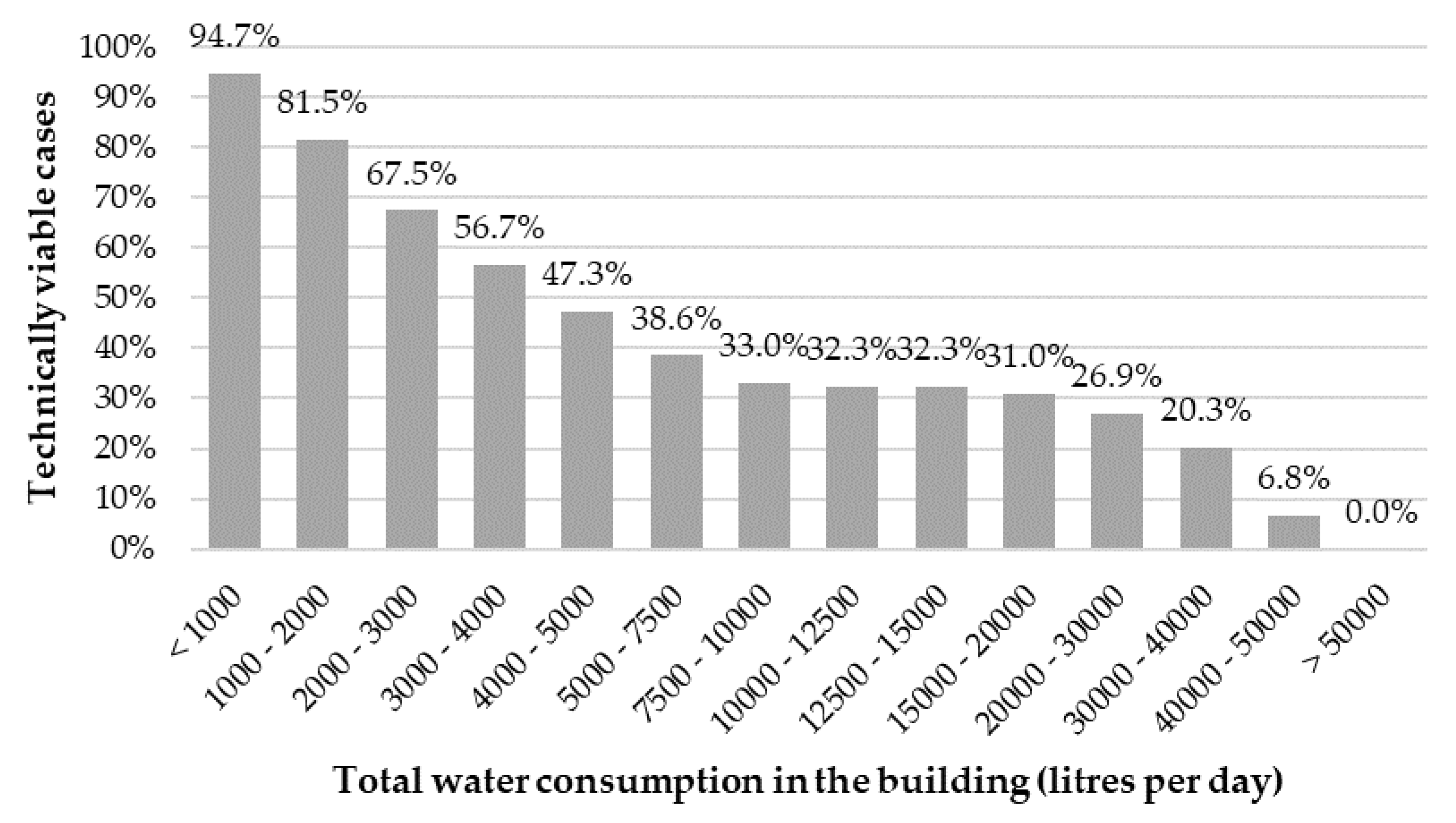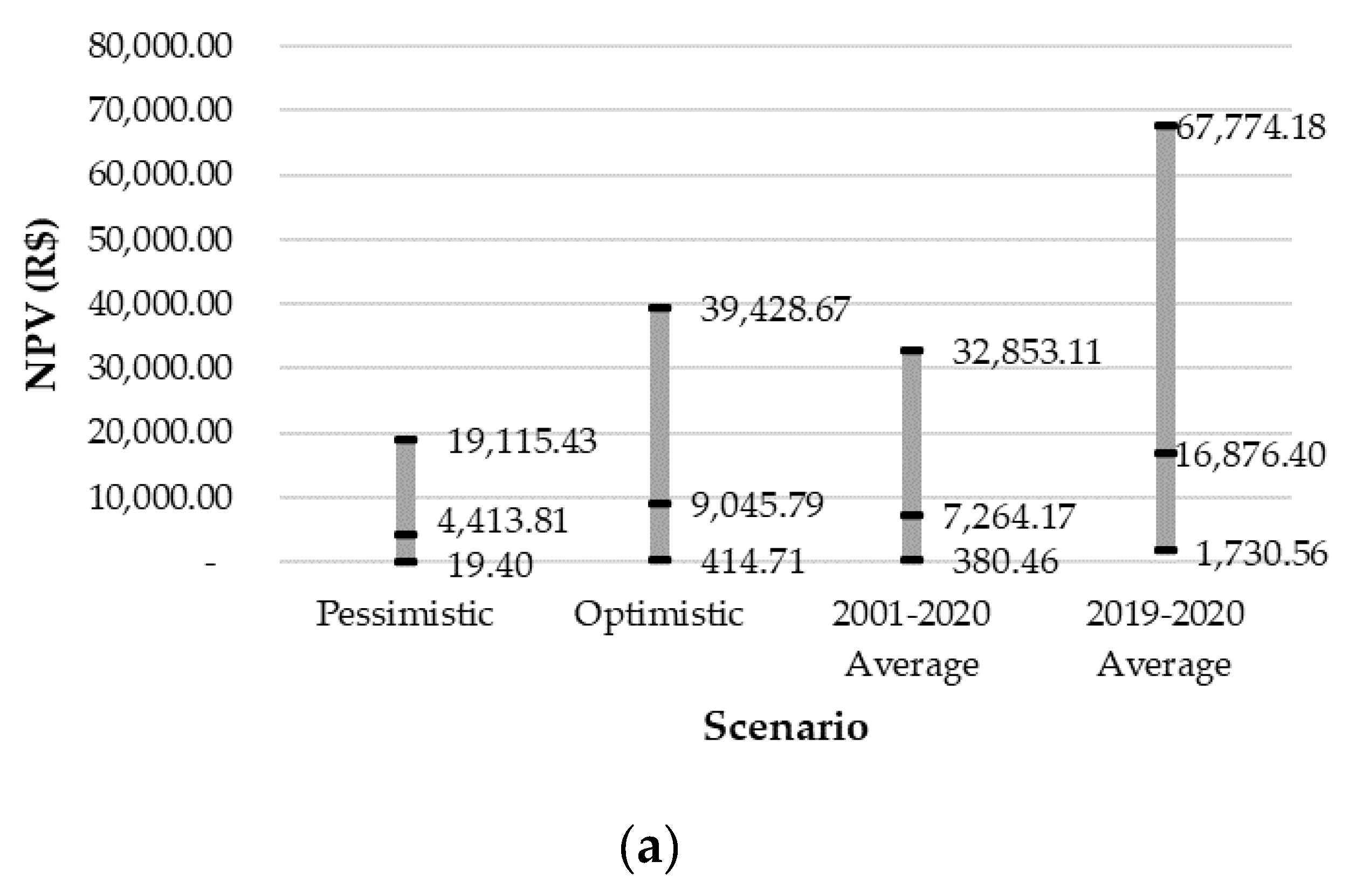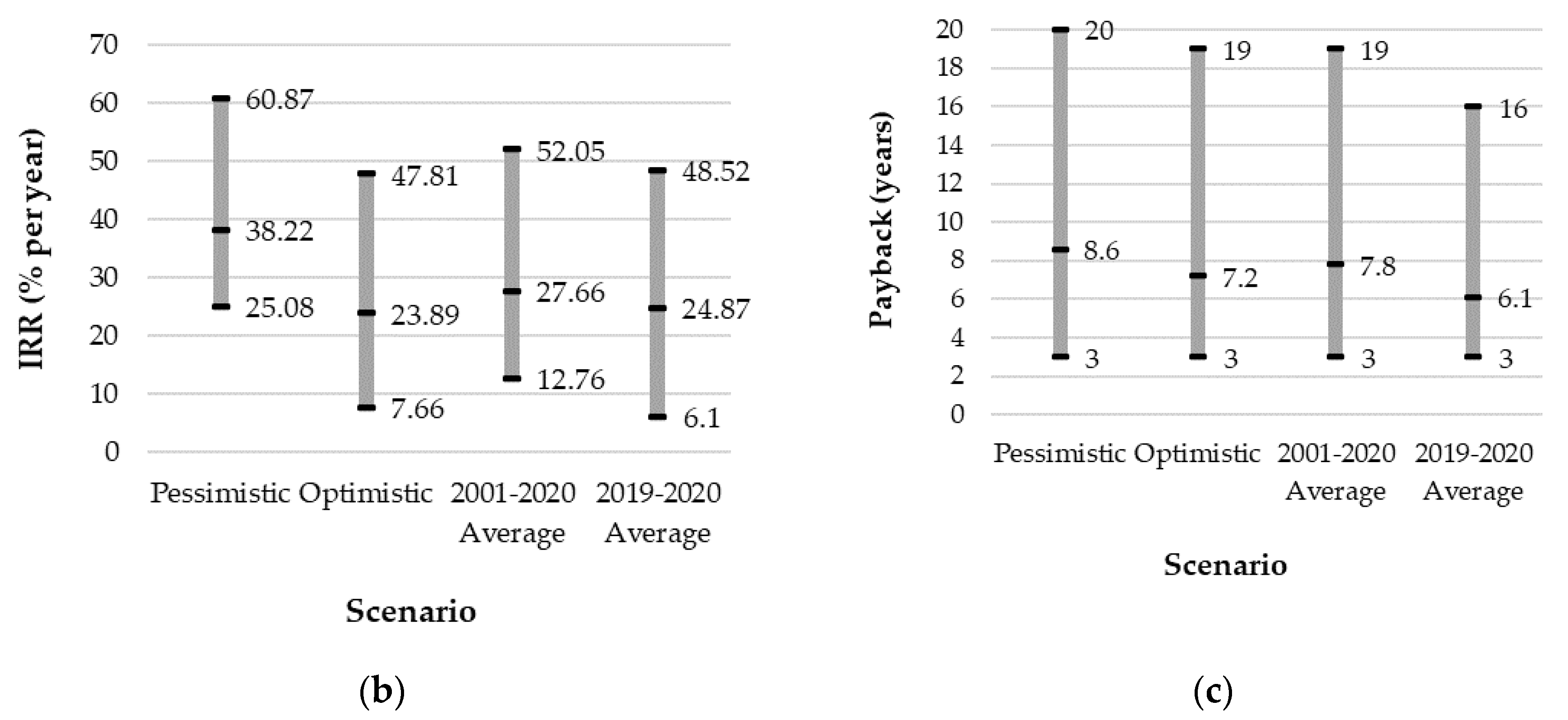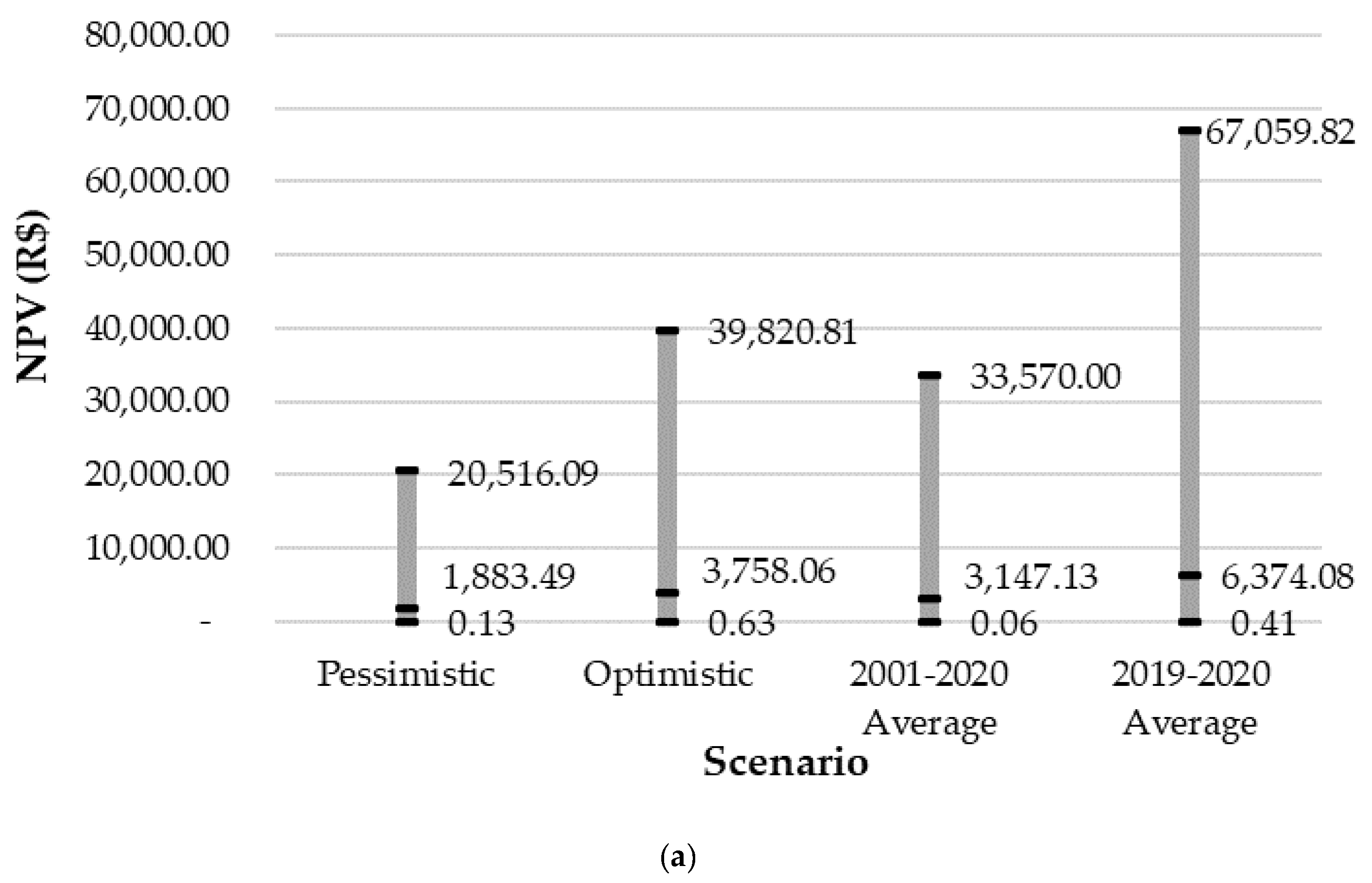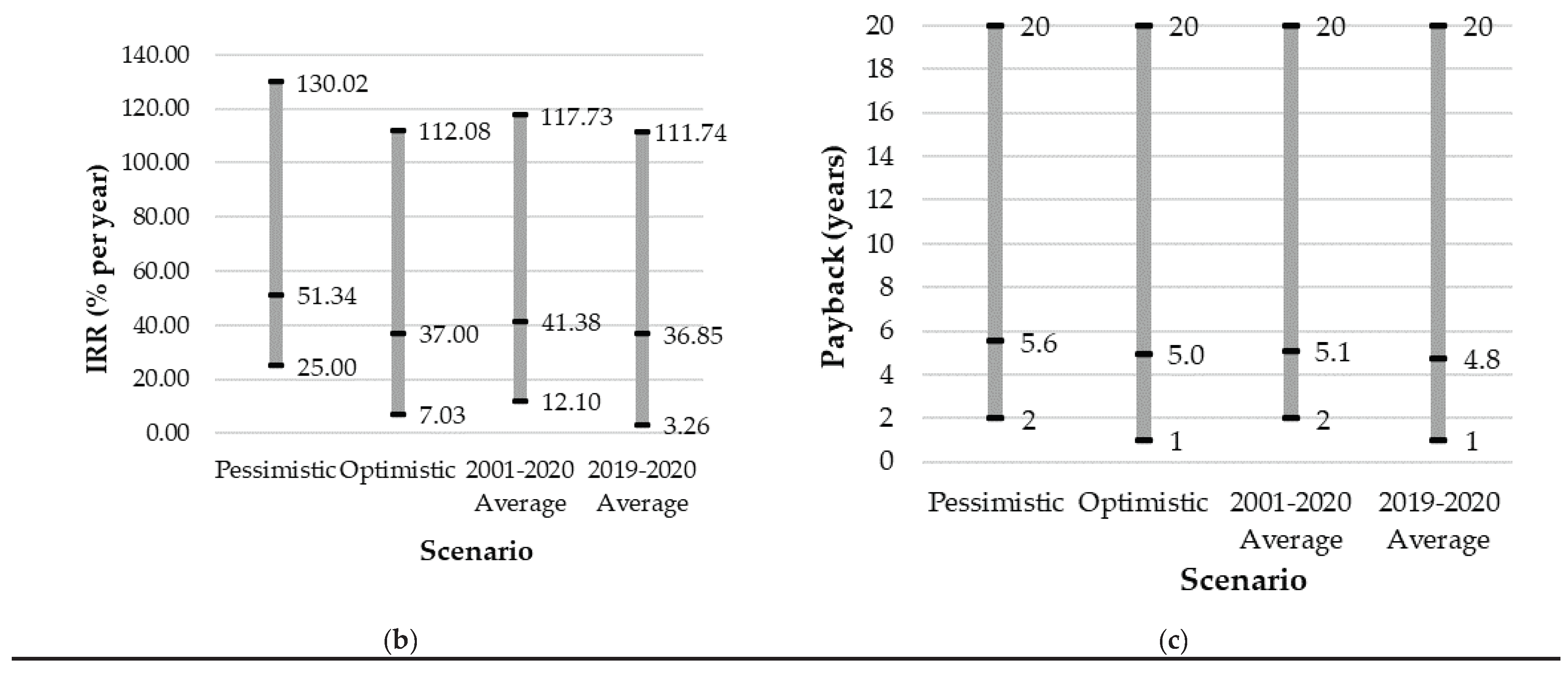1. Introduction
In recent years, freshwater availability has been decreasing worldwide, a phenomenon driven by population growth and increased demands from the agriculture, industry, and energy sectors. Additionally, the impacts of climate change have rapidly deteriorated the quality and quantity of freshwater, leading to drier conditions in various regions across continents [
1]. In search of alternative sources, some strategies for using the water available within the city, such as greywater reuse, rainwater harvesting and, in the case of coastal cities, seawater desalination, have the potential to supply 15% to 80% of water demand in some locations [
2].
Rainwater harvesting has been employed since ancient times and is currently considered an alternative to reduce the consumption of potable water in buildings in many countries [
3,
4,
5,
6,
7,
8]. When compared to other strategies such as water-saving devices and greywater reuse, rainwater harvesting has demonstrated more efficient results [
9]. When combined, these three strategies achieve the highest potential for potable water savings [
10] while also contributing to energy savings in the city by reducing the water and sewage treatment needs for the utility company [
11]. In addition to potable water savings, rainwater harvesting also helps reduce flooding in regions with high soil impermeability, as part of the water that would normally be drained is collected and stored [
12,
13].
Global literature indicates that rainwater harvesting systems have an average potential for potable water savings of 53% [
14]. In the city of Florianópolis, this potential ranges from 27% in June to 73% in February [
15]. Other studies in the region suggest that the potential for single-family residential buildings varies between 28% and 43%, while for multifamily buildings, it ranges from 7% to 42% [
4,
9,
16,
17,
18,
19,
20].
In recent years, the tariff format of the water service provided by the company supplying Florianópolis underwent changes to encourage conscious water use. The current tariff format no longer considers a minimum water consumption of 10m³ per dwelling and determines the water bill based on the actual volume consumed. This changes the way economic analyses of rainwater harvesting systems are carried out and can impact the final feasibility results, as even dwellings with low consumption may now achieve monetary savings. Thus, this research stands out from previous studies as it examines a new scenario in the use of rainwater harvesting systems.
The overall objective of this study is to assess the economic feasibility of rainwater harvesting systems for representative residential buildings in Florianópolis after the implementation of the current tariff format in the city.
2. Materials and Methods
In order to achieve the objectives of this study, information about the study area was gathered, including rainfall data, water consumption data, details about dwellings and population statistics. Subsequently, representative buildings similar to actual residential buildings in the city were conceived. Different scenarios for potable water and rainwater use were also defined. Simulations were conducted using the Netuno programme [
21] to estimate the potential for potable water savings by means of rainwater harvesting in each of the representative buildings in all scenarios. Finally, economic analysis was performed for each case simulated to determine its feasibility, considering different water tariff formats.
2.1. Study Area
The study focuses on Florianópolis, Santa Catarina. The city has a population of 516,000 inhabitants, 675 square kilometres, and a population density of 623.68 inhabitants per square kilometre [
22]. Its location is indicated in
Figure 1. According to the Köppen-Geiger classification, the city is situated in a subtropical climate region, characterised by hot summers, infrequent frosts, and a tendency for concentrated rainfall in the summer months, with no clearly defined dry season [
23].
2.2. Rainfall Data
Daily records of rainfall volume in the city were obtained from the website of the National Institute of Meteorology [
24]. A historical series spanning ten years, from 2009 to 2018, was used, as this was the most recent period with no significant registration gaps. Studies suggest that this time span is sufficient to obtain results as reliable as longer historical series [
25,
26,
27].
Figure 2 shows the minimum, average and maximum monthly rainfall for Florianópolis.
2.3. Simulation Scenarios
In order to consider variations in water consumption and in rainwater demand, different simulation scenarios were taken into account. Four different numbers of residents per household were considered based on the average number of residents per household in the city, which was obtained by dividing the city’s total inhabitants by the total number of dwellings in the city according to the study’s database, resulting in an average of 3.72 residents. Thus, simulations were conducted for 2, 3, 4, and 5 residents per dwelling. For flats, in order to simulate the building as a whole, the number of residents per flat was multiplied by the number of units on the lot. Also, three daily per capita water consumption were taken into account, i.e. 100, 150, and 200 litres, based on the average in the city, according to the data gathered by the water company [
28].
To vary the rainwater demand, three rainwater harvesting system designs were conceived. Design 1 is a system intended to meet the demand for cleaning activities and external uses, representing on average 5% of household consumption. Design 2 is a system intended to meet only the demand for toilet flushing, considered as 30% of the household consumption. Design 3 aims to meet the demand for all non-potable activities, including toilet flushing, washing machine, cleaning activities and external uses, resulting in 50% of the total household consumption. The rainwater demand percentages for each activity were based on literature data [
9,
16,
17,
18,
20,
28,
29,
30].
By combining the daily per capita water consumption, the number of residents per household and the rainwater demand for each system design, 36 simulation scenarios were arranged, as summarised in
Table 1.
2.4. Representative Buildings
The data on the dwellings were obtained through electronic contact with the municipal department responsible for territorial management of the city. The information was processed and compiled into a database organised by lots. For each lot, information on the typology of the buildings constructed on it, the quantity of registered dwellings, and the sum of the horizontal projection area of all roofs was available. In total, the processed database contains 54,606 lots and 138,685 dwellings.
One of the main parameters for estimating the potable water savings due to rainwater harvesting systems is the catchment area, which in this study was considered as the building roofs. To determine the roof areas inputted in the simulations, representative buildings were conceived from the database.
Initially, the database was divided according to the typology of the buildings registered in the lots, resulting in two groups: houses or flats. For the group of houses, all lots registered according to this typology were considered. When there was only one dwelling registered on it, each lot was considered as a single building with a roof area equal to the total horizontal projection area of the lot. When there was more than one dwelling registered on the lot, it was considered that each dwelling represented a building with an average roof area obtained by dividing the total projection area of the lot by the number of dwellings registered on it.
For the group of flats, all lots registered with this typology were considered as a single building with multiple dwellings and a roof area equivalent to the total horizontal projection area of the lot. The group of flats was later divided into subgroups according to the number of flats per building.
Next, a frequency distribution analysis of the group of houses and subgroups of flats according to the building roof area was carried out, establishing roof size categories. For the group of houses, the number of categories into which the group was divided was determined according to Rice’s formula, using Equation 1.
Where:
is the number of categories;
is the number of buildings in the group.
The group of houses was then divided into k categories with equal intervals. For each category, a representative building was chosen, corresponding to all buildings within its interval, with its roof area being the average of the roof area of all real buildings in the interval.
For flats, each subgroup was divided into categories according to the square root formula, using Equation 2.
Where:
is the number of categories;
is the number of buildings in the subgroup.
In this case, the categories were divided into non-equal intervals according to the natural breaks method, which seeks to minimise variance within categories and maximise differences between them. For this, the Excel Real Statistics Resource Pack extension was used [
31]. A representative building was also chosen for each category, with a roof area equal to the average of all buildings in the interval.
2.5. Rainwater Harvesting Systems Simulation
The simulation of rainwater harvesting systems was conducted using the Netuno programme [
21]. The input parameters included daily rainfall data, first flush, catchment area, daily per capita water consumption, number of residents, rainwater demand, and runoff coefficient. Daily rainfall data were obtained from the INMET website [
24]. The first flush was set at 2 mm, following the Brazilian standard for rainwater harvesting systems [
32]. The catchment area was considered as the roof area of the representative building. The number of residents, daily per capita water consumption, and rainwater demand were considered according to each scenario. The runoff coefficient considered was 0.8, as it is the average value for ceramic tile or fibre-cement roofs [
33].
During the simulation, in order to determine the potable water savings, it was necessary to size the rainwater storage tanks. For houses in scenarios with system design 1, only one lower tank defined by the programme was considered. For houses in scenarios with designs 2 and 3, and for flats in all scenarios, two tanks were considered: a larger lower tank that supplies an upper tank by means of a pump. In these cases, the capacity of the upper tank was considered to meet the daily rainwater demand of the building, while the size of the lower tank was defined according to the ideal capacity suggested by the programme. In scenarios with system design 1, the lower tank was simulated for capacities between 100 and 5,000 litres for houses and 100 and 15,000 litres for flats, both varying in intervals of 100 litres. For scenarios with designs 2 and 3, capacities between 1,000 and 15,000 litres were simulated for houses and between 1,000 and 60,000 litres for flats, both varying in intervals of 1,000 litres. In all simulations, the ideal capacity was indicated when the difference in potable water savings between subsequent tank capacities was less than 1%/m³.
As a result of the simulations, the rainwater harvesting potential of each representative building for each scenario was obtained. The size of the lower tank was also determined, being the capacity indicated as ideal by the Netuno programme.
2.6. Technical Viability Assessment
From the results of the simulations, the technical viability of different system designs was analysed. The system was deemed technically viable when the potential for potable water savings reached at least 90% of the rainwater demand of the system design. Thus, cases that achieved the following were considered technically viable: 4.5% potential water savings for design 1, which aims to supply rainwater to meet the demand for cleaning activities and external uses, equivalent to a rainwater demand of 5% of the household water demand; 27% for design 2, to supply the demand for toilet flushing, equivalent to 30% of the household water demand; and 45% for design 3, to supply all non-potable activities in the dwelling, equivalent to 50% of the household water demand.
From the technical viability, a new parameter was formulated in order to analyse the catchment area necessary based on the monthly volume of rainwater consumed, using Equation 3. Thus, the minimum catchment area necessary to collect one cubic metre of rainwater monthly was considered the smallest value of this parameter for the simulations deemed technically viable.
Where:
is the necessary catchment area per volume of rainwater consumed monthly (m²/m³);
is the roof area of the building simulated (m²);
is the number of residents in the scenario simulated;
is the total daily per capita water consumption in the scenario simulated (litres);
is the rainwater demand (%).
2.7. Economic Feasibility Assessment
The economic feasibility analysis was conducted using an Excel spreadsheet. Costs were estimated for both the installation of the rainwater harvesting system, referred to as initial costs, and the expenses associated with its operation, the operational costs.
The initial costs included expenses on materials and labour. The materials considered were the lower and upper tanks, which were polyethylene water tanks, the pump, and other accessories such as PVC pipes, excluding gutters. Pumps were not accounted for in the simulations of houses under scenarios with system design 1, as this design does not require water pumping since it only has a lower tank. Material prices were determined through market research from local stores and suppliers, and labour costs were obtained from the National System of Costs and Construction Indexes (SINAPI) for October 2021 in the state of Santa Catarina. As accessory’s costs depend on the system design, it was estimated that these components represent 15% of the initial cost, i.e. the cost of tanks, pump, and labour, as in [
8].
Operational costs included energy for the pump operation, supplies for water treatment, and system maintenance. Chlorine tablets were considered as water treatment, with the cost per cubic meter of treated water was obtained through local store research. The annual maintenance cost for the system was estimated at 1% of the initial cost, as [
34]. The operation energy cost was obtained from the pump characteristics, the monthly pumped water volume, and the energy tariff price. The energy tariff price with taxes applied was obtained from the website of the local energy supplier for December 2021 [
35]. The water volume pumped is equivalent to the system’s monthly rainwater consumption.
On the other hand, the economic benefit was obtained by means of the reduction in the water and sewage bill resulting from potable water savings. Based on the daily per capita water consumption and the number of residents per dwelling in each scenario, the total water consumption for the dwelling was calculated over a month by multiplying such values by 30 days. Thus, the water and sewage bill without the rainwater harvesting system was calculated based on the tariff prices and the monthly total water consumption for the dwelling. Subsequently, the monthly potable water savings by the system was subtracted from the monthly total water consumption, and the water and sewage bill was recalculated. The difference in the bills with and without the rainwater harvesting system resulted in the monthly monetary savings.
Analyses were conducted considering both the former water tariff format and the current one to compare whether the system’s viability is altered and which one brings more benefits to users. The former tariff format considered a minimum fee for consumption up to 10m³, beyond which the amount was charged per each m³ of water consumed, varying in consumption intervals. The current tariff format, implemented in 2020, no longer has a minimum consumption, considering a fixed fee for infrastructure availability and fees per m³ of water consumed, also varying in intervals. Tariff values for 2019, representing the former tariff format, and 2021, the current one, were used. These values were obtained from the water company’s website [
36].
An annual cash flow was formed for a twenty-year period, as in [
8], and the discounted payback, internal rate of return (IRR), and net present value (NPV) were considered as feasibility indicators. A minimum attractive rate of return (MARR) was also considered, and adjustments for water and electricity tariffs followed in line with inflation. The inflation used was the Broad Consumer Price Index (IPCA), which is the official government index, and the MARR considered was the Selic index, on which is based the interest rates of savings accounts in Brazil.
Four different economic scenarios were evaluated: one pessimistic, one optimistic, and two averages. The pessimistic scenario considered the highest inflation of the last twenty years, and the optimistic scenario the lowest, alongside the Selic index of the same year. One of the average scenarios, called the 2001-2020 average scenario, considered the average inflation and Selic of the last twenty years, while the other, called the 2019-2020 average scenario, considered the averages only of the last two available years. For this, IPCA and Selic index were obtained from the Central Bank website [
37,
38]. As Selic varies throughout the months, the value considered was the one valid on December 31 of each year.
Table 2 shows the scenarios evaluated. The pessimistic scenario occurred in 2002, and the optimistic one in 2017; the 2001-2020 average considered values between 2001 and 2020, and the 2019-2020 average considered values from 2019 and 2020. To compare tariff formats, only the 2019-2020 average scenario was used.
The economic analysis was conducted for each case simulated. For the flat group, despite simulations being performed as collective systems and considering water consumption for the entire building, the economic analysis was carried out for each flat. Therefore, individual water bills were considered, with the average water consumption for the building, and the initial and operational system costs were divided among the flats in the building. Finally, the economic feasibility of each case was examined. The investment was considered economically feasible when the discounted payback was less than the analysis period, the NPV was positive, and the IRR was greater than the MARR.
3. Results
3.1. Representative Buildings
For the group of houses, the database contains 67,784 units, with roof areas ranging from 27.01 m² to 996.88 m². Thus, 82 categories were established, arranged into equal intervals of 11.83 m² each. Therefore, 82 representative buildings were chosen, one for each category, with their roof areas being the averages of the real buildings’ roof areas within the category. Each representative building corresponds to a percentage of real houses in the city.
Figure 3 shows the frequency distribution of the first 40 categories, encompassing buildings with a roof area of up to 500 m². Approximately 47% of the houses have a roof area lower than 110 m², and less than 2% have an area exceeding 500 m².
For the group of flats, the database comprises 2,248 buildings with varying number of flats, ranging from 2 to 795 flats per building. However, only buildings with up to 110 flats were considered, representing 95% of the multifamily buildings. Thus, 107 subgroups of flats were obtained. For each subgroup, the frequency distribution was conducted based on the roof area of each building. Therefore, 443 representative buildings were chosen, with a roof area equal to the average roof area of the real buildings within the category, and this area was used in the simulations. Each representative building corresponds to a percentage of the flats in its subgroup, which corresponds to a percentage of the total flats in the city. Approximately 70% of the multifamily buildings have up to 30 flats, indicating a predominance of smaller multifamily buildings in the city.
3.2. Potential for Potable Water Savings
From the representative buildings, it was possible to assess the potential for potable water savings for different scenarios. For the group of houses, 82 representative buildings were simulated in the 36 scenarios, resulting in 2,952 simulation cases. Technical viability was analysed for each case to determine if the system simulated achieved potential for potable water savings close to the rainwater demand.
Table 3 summarises the results: 100% of the cases were viable for using rainwater to meet the demand for cleaning and external uses, i.e. for design 1; 98.6% to supply the demand for toilet flushing, in design 2; and 95.0% for all non-potable activities in the dwelling, in design 3. Of the cases that did not reach technical viability, the average potential for potable water savings was 21.3% and 33.6% for designs 2 and 3, respectively.
Technical viability was also assessed according to other simulation parameters.
Figure 4(a) shows that the higher the total daily water consumption of the house, the lower the fraction of viable cases. For the catchment area, the smaller the roof area, the lower the fraction of viable cases, as shown in
Figure 4(b). Amongst the total technically unviable cases, 85.7% are for houses with total water consumption exceeding 500 litres daily, while 87.3% are for houses with roof area smaller than 100m². There were no unviable cases for houses with a catchment area greater than 200m². Additionally, considering the parameter of the catchment area needed per volume of rainwater consumed monthly, it was found that at least 8.88 m² of roof area are required for each m³ of rainwater one wishes to consume.
For the subgroups of flats, 443 representative buildings were simulated for the same 36 scenarios, resulting in 15,948 simulations. The technical viability of the flats was also verified, with the analysis divided by the number of flats in the building, as shown in
Table 4. The more flats the building has, the lower the proportion of viable cases and the potable water savings for unviable cases. Considering buildings with up to 30 flats, which are predominant in the city, 97.2% of cases were technically viable for design 1, while 28.9% for design 2 and 14.5% for design 3. There were no viable cases for design 2 in buildings with 34 or more flats and for design 3 from 21 flats onwards. Considering all simulations in the group, a total of 78.8% of cases were viable for design 1, 14.4% for design 2, and 7.1% for design 3. For cases that were not viable, the average potential for potable water savings were 3.8% for the first design, 13.7% for the second, and 16.7% for the third.
Similar to the group of houses, for flats, the greater the daily total water consumption in the building, the lower the fraction of technically viable cases, as shown in
Figure 5. However, regarding the catchment area, the fraction of viable cases remained around 33.8% regardless of the roof area of the building, as shown in
Figure 6. Amongst technically unviable cases, 72.3% were for buildings with consumption exceeding 10,000 litres per day. Finally, the minimum catchment area needed per volume of rainwater consumed monthly was found to be 9.97 m²/m³.
The proportion of viable cases is much higher for the group of houses, and the average potential for potable water savings of unviable cases is also higher. This is due to the fact that multifamily buildings have a much higher total water consumption than single-family buildings, as they have more families living in them. To meet this demand, the system would need a larger catchment area. However, even though multifamily buildings have a high number of flats, their roof area is not necessarily larger. Another aspect to consider is that, due to limitations in the study’s database, each lot containing flats was considered as a single building. Therefore, for lots with many dwellings and possibly more than one building, the simulations were carried out considering only one building and one single rainwater harvesting system. However, for multifamily buildings with many flats, it would be interesting to design more than one system, so that each would supply part of the households and thus reduce the capacity of the tanks. It is also important to note that technical viability was based on the simulated system application scenarios, so unviable cases may be viable under other system designs with different rainwater demand.
3.3. Economic Feasibility
Based on the results of the simulations, it was possible to perform economic analyses of rainwater harvesting systems for various scenarios of inflation and MARR, as shown in
Table 2 previously presented. Thus, the economic viability of each case was verified based on discounted payback period, NPV and IRR. In this step, the current tariff format was considered.
For the group of houses, all 2,952 simulations were analysed in the four economic scenarios: pessimistic, optimistic, 2001-2020 average, and 2019-2020 average, resulting in 11,808 assessment cases.
Table 5 summarises the fraction of economically feasible systems for each scenario and the averages for each feasibility indicator, while
Figure 7 shows the minimum, maximum and average indicators. The scenario that presented the best results was the 2019-2020 average, with a higher number of feasible systems and a shorter payback period. Amongst the unfeasible systems, the parameter of most impact was the total water consumption in the house. For the pessimistic scenario, 62.7% of the unfeasible cases happened for houses with total water consumption lower than or equal to 300 litres per day, equivalent to 9m³ per month, while 90.6% happened for consumption lower than or equal to 400 litres per day or 12m³ per month. In this scenario, the only circumstance that did not present any unfeasible cases was for houses with consumption of 1000 litres per day, that is, 30m³ per month. For the optimistic, 2001-2020 average, and 2019-2020 average scenarios, on average 98.3% of the unfeasible cases happened for houses with total water consumption lower than or equal to 300 litres per day. For all scenarios, 100% of houses with total consumption lower than or equal to 9m³ per month were unfeasible.
For the group of flats, the 15,948 simulations analysed in the four economic scenarios resulted in 63,792 assessment cases.
Table 6 and
Table 7 summarise the results of feasible cases for each scenario according to the number of flats in each building, while
Figure 8 shows the minimum, maximum and average indicators for all the buildings. Once again, the 2019-2020 average scenario presented the best results, and total water consumption of the flat was the most impactful parameter. It can be observed that, for all scenarios, the proportion of feasible cases remains almost constant for buildings with up to 50 flats, decreasing thereafter and reaching almost zero for buildings up to 100 flats. Considering the unfeasible cases, 59.3% of cases in the pessimistic scenario happened for buildings with average consumption per flat lower than or equal to 300 litres per day and 69.2% for consumption lower than or equal to 400 litres per day. In the optimistic, 2001-2020 average, and 2019-2020 average scenarios, on average, 66.6% of unfeasible cases happened in flats with consumption lower than or equal to 300 litres per day and 74.2% for consumption lower than or equal to 400 litres per day. Except for the 2019-2020 average scenario, 100% of buildings with consumption per flat lower than or equal to 300 litres per day were unfeasible.
3.4. Tariff Format Comparison
Using the 2019-2020 average economic scenario, both tariff formats were compared, with the results for the group of houses summarised in
Table 8 and for the group of flats in
Table 9. For the group of houses, the change in the tariff format had almost no difference in the quantity of economically feasible cases, but it had a significant impact on the feasibility indicators. The current tariff format showed higher NPV and IRR, while the discounted payback was over one year shorter. For the group of flats, the former tariff format had a smaller fraction of feasible cases, as well as worse values for the feasibility indicators. Thus, the current tariff format leads to more benefits and greater incentive for users seeking to save potable water.
4. Discussion
The average payback found in this study, both for houses and flats, is within the values described in the literature [
39], while the values for the IRR were higher [
34]. However, the IRR is an indicator that its absolute value is intrinsic to the economic scenario analysed, while NPV and payback can be directly compared between different cases and scenarios. Thus, it is observed that both for houses and flats, the 2019-2020 average scenario achieved better results, as it had a higher NPV and a shorter payback. Since for flats the system costs were divided among all flats in the building, the investment per household was lower, resulting in higher IRR and a shorter payback for this group when compared to the group of houses.
Overall, it is evident that rainwater harvesting systems are economically feasible for many cases and provide a good financial return when compared to other investments, such as savings accounts. Most economically unfeasible cases happened for buildings with low water consumption per dwelling, which has also been observed in other studies conducted in Brazil [
39,
40]. This can be explained by the fact that the water tariff is significantly lower for volumes below 10m³, so reducing the consumption of potable water does not result in significant monetary savings on the water and sewage bill. However, the decision to use rainwater harvesting systems should not be based solely on the economic aspect, as there are other benefits to be considered.
5. Conclusions
This study analysed the technical viability and economic feasibility of rainwater harvesting systems for residential buildings in Florianópolis, southern Brazil. A total of 18,900 simulations were conducted using the Netuno computer programme, and 94,500 economic analyses were performed using Excel spreadsheets to study various scenarios and cases of system application, including different tariff formats.
Representative buildings for the residential sector of the city were chosen from the database. It was observed that the majority of houses in the city have a roof area smaller than 200m², and most flats are in multifamily buildings with up to 30 flats. Simulations of rainwater harvesting systems were carried out for 36 different application scenarios for each representative building. For houses, almost all of the cases simulated were technically viable, and among the technically unviable cases, the average potable water savings were 21.3% for design 2 and 33.6% for design 3. For flats, up to 78.9% of the cases simulated were technically viable, and among the unviable cases, the average potable water savings were 3.8%, 13.7%, and 16.7% depending on the system design. Thus, the rainwater harvesting systems demonstrated good performance in terms of potable water savings for the houses, however, for flats, system designs with high rainwater demand had a lower percentage of viable cases. Therefore, all three system designs seem to be suitable for houses, while design 1, which aims to meet the demand only for cleaning activities and external uses, seems to be more adequate for flats.
The economic feasibility of the rainwater harvesting systems was also assessed. Twenty-year cash flows were analysed in four economic scenarios using Excel spreadsheets. The fraction of economically feasible cases ranged from 60.1% to 74.8% for houses and from 57.8% to 64.2% for flats. The average discounted payback period varied between 6.2 and 8.6 years for houses and between 4.8 and 5.6 for flats. For both, the majority of economically unfeasible cases happened for buildings with monthly water consumption lower than or equal to 9m3 per flat. Thus, rainwater harvesting systems are, in most cases, interesting and economically feasible alternatives for saving potable water in dwellings. To encourage its implementation by more people, it would be interesting to have financial incentives to make these systems economically feasible for low-consumption dwellings.
This study also compared the former tariff format, whose minimum rate is linked to a consumption of 10m³, with the current one implemented since 2020, that considers no minimum consumption, to determine which format brings more benefits to users. Through economic analysis, it was found that the change in the tariff did not significantly influence the number of economically viable cases. However, the current tariff brought greater monetary savings for feasible systems, increasing the NPV and reducing the payback period. Thus, it can be stated that the change was positive for users seeking ways to reduce water consumption and save potable water.
Funding
This research received no external funding.
Data Availability Statement
Not applicable.
Acknowledgments
The authors would like to thank CAPES — “Fundação Coordenação de Aperfeiçoamento de Pessoal de Nível Superior”, the Brazilian governmental agency that enabled the development of this research.
Conflicts of Interest
The authors declare no conflict of interest.
References
- United Nations Environment Programme. Freshwater. In Global Environment Outlook, 6th ed.; Cambridge, 2019; pp. 236–269. [Google Scholar]
- RYGAARD, M.; BINNING, P.J.; ALBRECHTSEN, H.J. Increasing urban water self-sufficiency: new era, new challenges. Journal of Environmental Management 2011, 92, 185–194. [Google Scholar] [CrossRef]
- ABDULLA, F.A.; AL-SHAREEF, A.W. Roof rainwater harvesting systems for household water supply in Jordan. Desalination 2009, 243, 195–207. [Google Scholar] [CrossRef]
- MARINOSKI, A.K.; GHISI, E. Environmental performance of hybrid rainwater-greywater systems in residential buildings. Resources, Conservation and Recycling 2019, 144, 100–114. [Google Scholar] [CrossRef]
- PALLA, A.; GNECCO, I.; LANZA, L.G.; LABARBERA, P. Performance analysis of domestic rainwater harvesting systems under various European climate zones. Resources, Conservation and Recycling 2012, 62, 71–80. [Google Scholar] [CrossRef]
- PAVOLOVÁ, H.; BAKALÁR, T.; KUDELAS, D.; PUŁKÁROVÁ, P. Environmental and economic assessment of rainwater application in households. Journal of Cleaner Production 2019, 209, 1119–1125. [Google Scholar] [CrossRef]
- SOUZA, E.L.; GHISI, E. Potable Water Savings by Using Rainwater for Non-Potable Uses in Houses. Water 2012, 4, 607–628. [Google Scholar] [CrossRef]
- FREITAS, D.A.; GHISI, E. Economic feasibility analysis of rainwater harvesting: a case study in Imbituba, brazil. Urban Water Journal 2020, 17, 905–911. [Google Scholar] [CrossRef]
- VIEIRA, A.S. Uso racional de água em habitações de interesse social como estratégia para a conservação de energia em Florianópolis, Santa Catarina. Masters. Federal University of Santa Catarina, Florianópolis. 2012. [Google Scholar]
- GHISI, E.; RUPP, R.F.; TRISKA, Y. Comparing indicators to rank strategies to save potable water in buildings. Resources, conservation and recycling 2014, 87, 137–144. [Google Scholar] [CrossRef]
- PROENÇA, L.C.; GHISI, E.; TAVARES, D.F.; COELHO, G.M. Potential for electricity savings by reducing potable water consumption in a city scale. Resources, Conservation and Recycling 2011, 55, 960–965. [Google Scholar] [CrossRef]
- GONÇALVES, R.F. Uso Racional da Água em Edificações. Rio de Janeiro: ABES. 2006. [Google Scholar]
- TESTON, A.; TEIXEIRA, C.A.; GHISI, E.; C., E.B. Impact of rainwater harvesting on the drainage system: case study of a condominium of houses in Curitiba, Southern Brazil. Water 2018, 10, 1100.
- TESTON, A.; GERALDI, M.; COLASIO, B.; GHISI, E. Rainwater Harvesting in Buildings in Brazil: a literature review. Water 2018, 10, 471–496. [Google Scholar] [CrossRef]
- GHISI, E.; MONTIBELLER, A.; SCHMIDT, R.W. Potential for potable water savings by using rainwater: an analysis over 62 cities in southern Brazil. Building and Environment 2006, 41, 204–210. [Google Scholar] [CrossRef]
- GHISI, E.; FERREIRA, D.F. Potential for potable water savings by using rainwater and greywater in a multi-storey residential building in southern Brazil. Building and Environment 2007, 42, 2512–2522. [Google Scholar] [CrossRef]
- GHISI, E.; OLIVEIRA, S.M. Potential for potable water savings by combining the use of rainwater and greywater in houses in southern Brazil. Building and Environment 2007, 42, 1731–1742. [Google Scholar] [CrossRef]
- GHISI, E.; THIVES, L. P.; MEINCHEIM, D. L. Potential for potable water savings by using rainwater in a house in southern Brazil. Proceedings of IWA EFFICIENT 2017 - 9TH BIENNIAL SPECIALIST CONFERENCE ON EFFICIENT USE AND MANAGEMENT OF WATER; 2017. [Google Scholar]
- MARINOSKI, D.L.; GHISI, E.; GÓMEZ, L.A. Aproveitamento de água pluvial e dimensionamento de reservatório para fins não potáveis: estudo de caso em um conjunto residencial localizado em Florianópolis-SC. Proceedings of Conferência Latino-Americana de Construção Sustentável, 1, Encontro Nacional de Tecnologia do Ambiente Construído, 10, São Paulo, Brazil; 2004. [Google Scholar]
- MAYKOT, J.K.; GHISI, E. Assessment of A Rainwater Harvesting System in A Multi-Storey Residential Building in Brazil. Water 2020, 12, 546–568. [Google Scholar] [CrossRef]
- GHISI, E.; CORDOVA, M.M. Netuno 4. Programa computacional. Universidade Federal de Santa Catarina, Departamento de Engenharia Civil. Available online: http://www.labeee.ufsc.br/. 2014 (accessed on 25 October 2021).
- IBGE – Instituto Brasileiro de Geografia E Estatística. Portal Cidades. Available online: https://cidades.ibge.gov.br/brasil/sc/florianopolis/panorama (accessed on 25 October 2021).
- PANDOLFO, C.; BRAGA, H. J.; SILVA JR, V. P.; MASSIGNAM, A. M.; PEREIRA, E. S.; THOMÉ, V. M. R.; VALCI, F.V. Atlas climatológico do Estado de Santa Catarina. Florianópolis: Epagri. 2002. Available online: https://ciram.epagri.sc.gov.br/ciram_arquivos/atlasClimatologico/atlasClimatologico.pdf (accessed on 25 October 2021).
- INMET – Instituto Nacional de Metereologia. Banco de dados Meteorológicos. Available online: https://bdmep.inmet.gov.br/# (accessed on 25 February 2021).
- GERALDI, M.S.; GHISI, E. Influence of the length of rainfall time series on rainwater harvesting systems: a case study in berlin. Resources, Conservation and Recycling 2017, 125, 169–180. [Google Scholar] [CrossRef]
- GERALDI, M.S.; GHISI, E. Assessment of the length of rainfall time series for rainwater harvesting in buildings. Resources, Conservation and Recycling 2018, 133, 231–241. [Google Scholar] [CrossRef]
- GHISI, E.; CARDOSO, K.A.; RUPP, R.F. Short-term versus long-term rainfall time series in the assessment of potable water savings by using rainwater in houses. Journal of Environmental Management 2012, 100, 109–119. [Google Scholar] [CrossRef]
- SNIS – Sistema Nacional de Informações Sobre Saneamento. Diagnóstico dos Serviços de Água e Esgotos, 25th ed.; SNS/MDR: Brasília, Brazil, 2020. [Google Scholar]
- MARINOSKI, A.K.; VIEIRA, A.S.; SILVA, A.S.; GHISI, E. Water End-Uses in Low-Income Houses in Southern Brazil. Water 2014, 6, 1985–1999. [Google Scholar] [CrossRef]
- HAMMES, G.; GHISI, E.; THIVES, L.P. Water end-uses and rainwater harvesting: a case study in brazil. Urban Water Journal 2020, 17, 177–183. [Google Scholar] [CrossRef]
- Real Statistics Using Excel. Available online: https://www.real-statistics.com/multivariate-statistics/cluster-analysis/jenks-natural-breaks/ (accessed on 26 November 2021).
- ABNT—Associação Brasileira de Normas Técnicas. NBR 15527: Água de Chuva—Aproveitamento de Coberturas em Áreas Urbanas Para Fins Não Potáveis—Requisitos, 2nd ed; ABNT—Associação Brasileira de Normas Técnicas: Rio de Janeiro, Brazil, 2019; pp. 1–10. [Google Scholar]
- Plínio Tomáz Engenharia – Aproveitamento de Água de Chuva. Available online: https://www.pliniotomaz.com/ (accessed on 02 February 2021).
- SEVERIS, R.M.; SILVA, F.A.; WAHRLICH, J.; SKORONSKI, E.; SIMIONI, F.J. Economic analysis and risk-based assessment of the financial losses of domestic rainwater harvesting systems. Resources, Conservation and Recycling. 2019; 146, 206–217. [Google Scholar]
- CELESC – Centrais Elétricas de Santa Catarina. Tarifas e taxas de energia. Available online: https://www.celesc.com.br/tarifas-de-energia#tributos (accessed on 17 December 2021).
- CASAN – Companhia Catarinense de Água e Saneamento. Tarifas. Available online: https://www.casan.com.br/menu-conteudo/index/url/tarifas#0 (accessed on 17 December 2021).
- BCB – Banco Central do Brasil. Taxas de juros básicas: Histórico. Available online: https://www.bcb.gov.br/controleinflacao/historicotaxasjuros (accessed on 17 December 2021).
- BCB – Banco Central do Brasil. Histórico das metas para a inflação. Available online: https://www.bcb.gov.br/controleinflacao/historicometas (accessed on 17 December 2021).
- GHISI, E.; SCHONDERMARK, P.N. Investment Feasibility Analysis of Rainwater Use in Residences. Water Resources Management 2013, 27, 2555–2576. [Google Scholar] [CrossRef]
- BERWANGER, H.; GHISI, E. Investment feasibility analysis of rainwater harvesting in the city of Itapiranga, Brazil. International Journal of Sustainable Human Development 2014, 2, 104–114. [Google Scholar]
|
Disclaimer/Publisher’s Note: The statements, opinions and data contained in all publications are solely those of the individual author(s) and contributor(s) and not of MDPI and/or the editor(s). MDPI and/or the editor(s) disclaim responsibility for any injury to people or property resulting from any ideas, methods, instructions or products referred to in the content. |
© 2024 by the authors. Licensee MDPI, Basel, Switzerland. This article is an open access article distributed under the terms and conditions of the Creative Commons Attribution (CC BY) license (http://creativecommons.org/licenses/by/4.0/).
